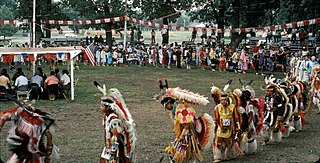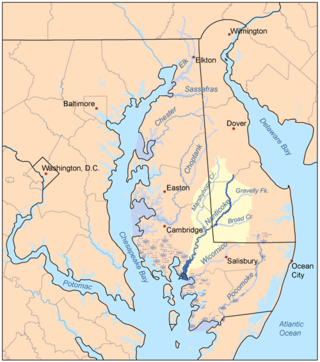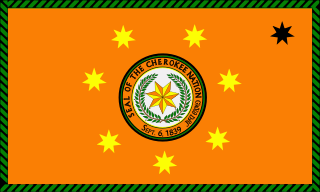Related Research Articles

The Lenape, also called the Lenni Lenape and Delaware people, are an Indigenous people of the Northeastern Woodlands, who live in the United States and Canada.
The Ramapough Mountain Indians, known also as the Ramapough Lenape Nation or Ramapough Lunaape Munsee Delaware Nation or Ramapo Mountain people, are a group of approximately 5,000 people living in and around the Ramapo Mountains of Bergen and Passaic counties in northern New Jersey and Rockland County in southern New York, about 25 miles (40 km) from New York City. They were recognized in 1980 by the state of New Jersey as the Ramapough Lenape Nation but are not recognized federally. Their tribal office is located on Stag Hill Road on Houvenkopf Mountain near Mahwah, New Jersey. Since January 2007, the chief of the Ramapough Lenape Nation has been Dwaine Perry.

A powwow is a gathering with dances held by many Native American and First Nations communities. Powwows today are an opportunity for Indigenous people to socialize, dance, sing, and honor their cultures. Powwows may be private or public, indoors or outdoors. Dancing events can be competitive with monetary prizes. Powwows vary in length from single-day to weeklong events.

Saginaw Chippewa Indian Tribe of Michigan is a federally recognized band of Chippewa located in central Michigan in the United States.
The Guilford Native American Association (GNAA) is a Native American community association in Guilford County, North Carolina. It is a North Carolina State-recognized American Indian Organization, and is a United Way referral agency.

The Haliwa-Saponi Indian Tribe, also the Haliwa-Saponi Tribe, is a state-recognized tribe and nonprofit organization in North Carolina. They are not federally recognized as a Native American tribe.

The Nanticoke people are a Native American Algonquian people, whose traditional homelands are in Chesapeake Bay and Delaware. Today they live in the Northeastern United States and Canada, especially Delaware; in Ontario; and in Oklahoma.

The Cherokee Nation, also known as the Cherokee Nation of Oklahoma, is the largest of three Cherokee federally recognized tribes in the United States. It includes people descended from members of the Old Cherokee Nation who relocated, due to increasing pressure, from the Southeast to Indian Territory and Cherokee who were forced to relocate on the Trail of Tears. The tribe also includes descendants of Cherokee Freedmen, Absentee Shawnee, and Natchez Nation. As of 2023, over 450,000 people were enrolled in the Cherokee Nation.

The Rappahannock are a federally recognized tribe in Virginia and one of the eleven state-recognized tribes. They are made up of descendants of several small Algonquian-speaking tribes who merged in the late 17th century. In January 2018, they were one of six Virginia tribes to gain federal recognition by passage of the Thomasina E. Jordan Indian Tribes of Virginia Federal Recognition Act of 2017.
The Nanticoke Lenni-Lenape Tribal Nation are a tribal confederation of Nanticoke of the Delmarva Peninsula and the Lenape of southern New Jersey and northern Delaware. They are recognized by the state of New Jersey, having reorganized and maintained elected governments since the 1970s. They are not a federally recognized tribe.
The Nansemond are the Indigenous people of the Nansemond River, a 20-mile-long tributary of the James River in Virginia. Nansemond people lived in settlements on both sides of the Nansemond River where they fished, harvested oysters, hunted, and farmed in fertile soil. Today, Nansemond people belong to the federally recognized Nansemond Indian Nation.
Cherokee heritage groups are associations, societies and other organizations located primarily in the United States. Such groups consist of persons who do not qualify for enrollment in any of the three federally recognized Cherokee tribes. As the Cherokee Nation enrolls all people who can prove descent from a Cherokee ancestor, many of these groups consist of those who claim Cherokee ancestry but have no documentation to prove this alleged heritage. Some have had their claims of ancestry checked and proven to be false. A total of 819,105 Americans claimed Cherokee heritage in the 2010 Census, more than any other named tribe in the Census.
Oak Orchard is an unincorporated community east of the town of Millsboro in Sussex County, Delaware, United States. Oak Orchard is bordered to the south by the Indian River Bay, to the east by Emily Gut and "the Peninsula", and to the north by Delaware Route 24.
Nanticoke is an Algonquian language formerly spoken in Delaware and Maryland, United States. The same language was spoken by several neighboring tribes, including the Nanticoke, which constituted the paramount chiefdom; the Choptank, the Assateague, and probably also the Piscataway and the Doeg.

Meskwakiinaki, also called the Meskwaki Settlement, is an unincorporated community in Tama County, Iowa, United States, west of Tama. It encompasses the lands of the Meskwaki Nation, one of three Sac and Fox tribes in the United States. The others are located in Oklahoma and Kansas. The settlement is located in the historic territory of the Meskwaki (Fox), an Algonquian people. Meskwaki people established the settlement in 1857 by privately repurchasing a small part of the land they had lost in the Sac and Fox treaty of 1842.
Antonio Arocho, more commonly known as Tony Arocho, is an attorney and former Chief Operating Officer of the Hispanic National Bar Association (2006–2008). He is the founder and principal attorney of the Arocho Law Office. He is a member of the District of Columbia and U.S. Virgin Islands bars. He is also admitted to practice before the U.S. Court of International Trade, and U.S. Court of Appeals for the Third Circuit.
The Nulhegan Band of the Coosuk Abenaki Nation is a state-recognized tribe and nonprofit organization, called AHA "Abenaki Helping Abenaki", whose headquarters and land are based in Vermont. They are often referred to as the Nulhegan Abenaki Tribe or simply, Nulhegan.
The Accomac people were a historic Native American tribe in Accomack and Northampton counties in Virginia. They were loosely affiliated with the Powhatan Confederacy.

The Indigenous peoples of Maryland are the tribes who historically and currently live in the land that is now the State of Maryland in the United States of America. These tribes belong to the Northeastern Woodlands, a cultural region.
The Accohannock Indian Tribe, Inc. is a state-recognized tribe in Maryland and a nonprofit organization of individuals who identify as descendants of the Accohannock people.
References
- ↑ "The backstory on the Nanticoke Indian Tribe". The News Journal. delawareonline.com. Retrieved August 11, 2008.
- ↑ "Chief Resigns", accessed 8 Oct 2009
- ↑ https://www.nanticokeindians.org/page/nanticoke-flag
- ↑ Weslager, Clinton (1983). The Nanticoke Indians Past and Present. Associated University Presses, Inc. pp. 216–218. ISBN 0874131790.